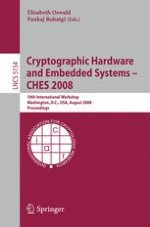2008 | Buch
Cryptographic Hardware and Embedded Systems – CHES 2008
10th International Workshop, Washington, D.C., USA, August 10-13, 2008. Proceedings
herausgegeben von: Elisabeth Oswald, Pankaj Rohatgi
Verlag: Springer Berlin Heidelberg
Buchreihe : Lecture Notes in Computer Science



